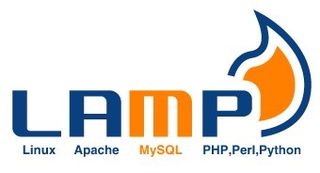Linux On The Server Really Sings

Figure 9: The Linux Apache MySQL and PHP/Perl/Python, or LAMP, icon
Two emerging Linux-centric trends spreading quickly include high-availability Web development platforms such as the highly successful LAMP project (Linux, Apache, MySQL, and PHP, Perl or Python), along with specialized, clustered computing applications. Through an industry-wide practice of decreasing IT operating costs, Linux has also proven effective at replacing both existing Windows and UNIX server installations running on older legacy hardware that can often be costly to maintain. The Linux platform has even proven successful in emerging trends such as virtualization, and embedded specialty niches like network attached storage and small-footprint network media devices.
Linux has also earned something of a seal of approval from numerous high-profile companies, among whose ranks you'll find Amazon and E*Trade. In addition to strategic partnerships with upper-level infrastructure vendors and original equipment manufacturers (OEMs) such as IBM, Dell, and Hewlett-Packard, governmental sources across the globe also show strong and continued interest in the continued development of the Linux platform, particularly in the server segment.

Figure 10: Asian Linux, aka Asianux, icons for Haansoft, Miracle, and Red Flag
Linux is also making major inroads throughout the Asian business world with the significant uptake of an officially recognized, regionally standardized, unified Linux framework that works in both the desktop and server market spaces. Throughout China, Japan, and Korea, efforts are well underway to establish an official localized "Linux of the Asias". An exemplary case of this is Asianux, a joint development between three major Asian Linux vendors: Red Flag Software of China, the Miracle Linux Corporation (58.5% of which is owned by USA-based Oracle Corporation) and Haansoft of South Korea.
Asianux, which is based on Red Hat, is a basis for high-availability server operating systems, as well as powerful desktops and servers that cater to the symbolic Asian languages native to these key areas. Most importantly, it isn't a full-fledged operating system, but the very foundation upon which an OS is built. This enables the competing companies to retain their original distribution identities while formalizing a single, certifiable, commonly accepted kernel and core components.
According to a statement made in 2005 by Sun Wah Linux CEO Alex Banh, the most profound motivation for this movement - beyond merely reducing the outlay on IT infrastructure costs - has been to enervate the Windows monopoly in China. In April 2005, Turbolinux boosted its subscriber base by approximately 100 million clients, when it signed a three-year integration deal with the Industrial Commercial Bank of China, which operates over 20,000 branches in mainland China.
Stay On the Cutting Edge: Get the Tom's Hardware Newsletter
Get Tom's Hardware's best news and in-depth reviews, straight to your inbox.
At the turn of the last century, Amazon.com publicly disclosed an astonishing $10 million savings when that online retailer shifted operations from proprietary UNIX servers to lower-cost Intel-based Linux machines. Indeed, many key players representing the best of breed in all industries have turned to Linux for one reason or another; chief among those reasons is a perceived lower total cost of ownership.
Current page: Linux On The Server Really Sings
Prev Page The Enterprise Is Heating Up Next Page Virtually VictoriousEd Tittel is a long-time IT writer, researcher and consultant, and occasional contributor to Tom’s Hardware. A Windows Insider MVP since 2018, he likes to cover OS-related driver, troubleshooting, and security topics.
Most Popular

